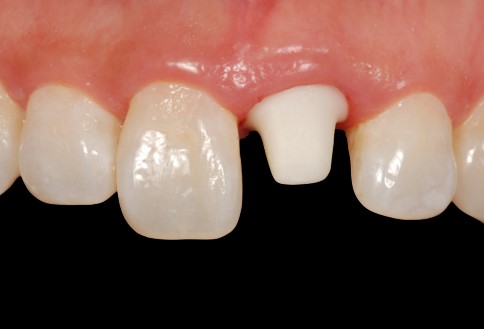Get in the Esthetic Zone: Implant Abutments
By Greggory Kinzer on June 18, 2015 | 1 comment
Today we have more options than ever before when deciding on an implant abutment in the esthetic zone. Should it be a custom abutment or a stock abutment? Should the abutment material be titanium, gold, zirconia or ceramo-metal? Although the decision is often left up the technician, I believe that it should be a joint discussion between both the dentist AND the dental technician.
In the esthetic zone, when deciding on a custom versus a stock abutment, it is important to remember the goals of the implant abutment. It is with the following two goals in mind that I find nearly all of my implant restorations in the esthetic zone are restored with custom abutments – or screw-retained restorations:
1. The abutment should support the peri-implant soft tissue, thereby creating an emergence profile that allows the implant restoration to mimic the soft profile tissue of the contra-lateral tooth.
2. Place the abutment crown interface in a location that will allow easy access and removal during the cementation process.

Given the differences in implant position (depth, angulation, mesial-distal) and the different shapes and sizes of teeth, a custom abutment is still the best way to ideally support the soft tissue that was created in the provisional phase and place the cement margin in an easily accessible location. (Figure 1)

It is well-documented in the literature that failure to remove residual cement can have disastrous long-term implications for the implant.1 Although the contours and options for stock abutments have greatly increased, I recommend they be used more in the posterior where the bone/soft tissue contours are flatter, and ideal support of the soft tissue is not critical esthetically. (Figure 2)
(Click this link for articles on dental esthetics.)
The choice of abutment material can also have a significant impact on the final esthetic outcome. A 2012 paper by Jung2 used a spectrophotometer to evaluate the color changes of the soft tissue by different restorative materials including titanium, titanium veneered with feldspathic ceramic, zirconia and zirconia veneered with feldspathic ceramic.
What I found was:
- All specimens induced overall color change of the tissue, which diminished with an increase in soft tissue thickness.
- Titanium induced the most prominent color change while zirconia induced the least.
- With a mucosal thickness of 3mm, no change in color could be distinguished by the human eye on any specimen, regardless of the material.

So, what this means to us clinically is that unless we have significant facial tissue thickness – either because the implant is placed palatally or because a subepithelial connective tissue was placed3 – using a custom zirconia abutment will significantly improve the soft tissue esthetics. (Figure 3)

Unfortunately there are still some implants, specifically the narrow diameter implants, that do not have zirconia abutment options available. In these situations, it is often necessary to use a custom metal-ceramic abutment. (Figure 4)
With all of the material and technique options for implants that are available to us today, we should approach each patient individually and remember the treatment objectives when determining the correct implant hardware to choose.
(Click this link for more articles by Dr. Gregg Kinzer.)
Gregg Kinzer, D.D.S., M.S., Spear Faculty and Contributing Author
References
- The positive relationship between excess cement and perio-implant disease: A prospective clinical endoscopic study. Wilson TG Jr. J Periodontol 2009;80(9):1388 – 92
- In vitro color changes of soft tissues caused by restorative materials. Jung RE, et al. Int J Periodontics Restorative Dent 2007 Jun;27(3)(9):251-7
- Crestal ridge width changes when placing implants at the time of tooth extraction with and without soft tissue augmentation after a healing period of 6 months: Report of 24 consecutive cases. Grunder E., Int J Periodontics Restorative Dent 2011:31:9-17
Comments
May 26th, 2022